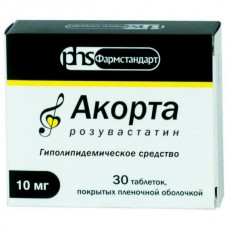Expiration date: 04/2026
The composition and form of issue
The HSE tablets, film-coated
1 tablet contains rosuvastatin 10 and 20 mg, pack of 30 PCs.
Pharmacological action:
The HSE - lipid-lowering drug, a selective competitive inhibitor of HMG-COA reductase converts 3-hydroxy-3-methylglutaric to mevalonate, a precursor of cholesterol.
The main target of action is the liver, where the cholesterol synthesis and catabolism of LDL. Inhibits the activity of HMG-COA reductase (the blood circulates 90% of the drug).
Increases the number of LDL receptors on the surface of hepatocytes, increasing the capture and catabolism of LDL, which leads to inhibition of the synthesis of VLDL, reducing the total number of LDL and VLDL.
Reduces the concentration of cholesterol-LPNP, cholesterol-elpvp, cholesterol, VLDL, total cholesterol, TG, TG-VLDL, apolipoprotein b (Apob), the ratio LDL cholesterol/HDL-cholesterol, total cholesterin/cholesterol-HDL, cholesterol-elpvp/cholesterol-HDL, Apob/Apoa-I, increases the concentration of HDL-cholesterol, Apoa-I. Hypolipidemic action directly proportional to the administered dose.
The therapeutic effect appears within 1 week after the start of therapy, after 2 weeks achieves 90% of maximum, the maximum effect is usually reached by 4 week and after that remains constant.
Effective in adult patients with hypercholesterolemia with or without hypertriglyceridemia (regardless of race, gender or age), including patients with diabetes mellitus and familial hypercholesterolemia.
The additive effect observed in combination with fenofibrate (in respect of reducing the concentration of TG) and nicotinic acid (to reduce the concentration of cholesterol-HDL).
Indications:
Primary hypercholesterolemia (type IIA, including family heterozygous hypercholesterolemia) hypercholesterolemia or mixed (type IIb) as an adjunct to diet when diet and. non-pharmacological treatments (physical exercise, weight reduction) is inadequate.
Family homozygous hypercholesterolemia as an adjunct to diet and. cholesterinspiegel therapy (LDL-apheresis) or if such therapy the patient is not suitable.
Contraindications:
- Hypersensitivity,
- liver disease in active phase (including the persistent increase in activity of "hepatic" transaminases, as well as any increased activity "liver" transaminases in the serum of more than 3 times compared with the upper limit of normal),
- expressed violations kidney function (Cheremensky, lactation, women of childbearing age not using adequate contraceptive methods
- the age of 18 years (efficacy and safety not established).
- With caution. Renal failure,
- hypothyroidism, personal or family history of hereditary muscular diseases and previous history of muscle toxicity when using other inhibitors of HMG-COA reductase inhibitors or fibrates),
- alcohol dependence,
- age older than 65 years
- liver diseases in history, sepsis, arterial hypotension,
- extensive surgical interventions, injuries,
- severe metabolic, endocrine or electrolyte disorders, proteinuria, uncontrolled epilepsy,
- Asians (Japanese and Chinese).
Method of application and doses
Inside, the tablet of the HSE not to chew or crush, swallow whole with water, reception is possible at any time of the day regardless of the meal. The recommended starting dose is 10 mg 1 time a day, if necessary dose can be increased to 20 mg after 4 weeks, increase dose to 40 mg only under medical supervision in patients with severe homozygous familial hypercholesterolemia with high risk of cardiovascular complications (especially in patients with familial hypercholesterolemia) who have not achieved the desired outcome of therapy at the dose of 20 mg.
Patients with risk factors for myopathy the initial dose should be 5 mg.
In appointing gemfibrozilom dose of rosuvastatin should not exceed 10 mg/day.
In renal insufficiency, mild or moderate severity, and in old uzraste dose adjustment is not required.
The experience of the drug in patients with hepatic insufficiency above 9 on a scale child-Pugh missing.
Side effects:
The incidence of side effects is dose dependent in nature: often (1-10%), less frequent (0.1-1%), rare (0.01-0.1%).
From the nervous system: often - headache, dizziness, asthenic syndrome, less frequently - anxiety, depression, insomnia, neuralgia, paresthesia.
By the blood: often - constipation, nausea, abdominal pain, frequency unknown reversible transient dose-dependent increase in activity of "hepatic" transaminases, less often - neuralgia (including diarrhea, flatulence, vomiting), gastritis, gastroenteritis.
The respiratory system: often - pharyngitis less often - rhinitis, sinusitis, asthma, bronchitis, cough, dyspnea, pneumonia.
From the heart rate: less often, angina, increased blood pressure, palpitations, vasodilation.
From the side of musculoskeletal system: often - myalgia, and less often - arthralgia, arthritis, hypertonia, back pain, abnormal pearl of the limb (without damage), rare - myopathy, rhabdomyolysis (at the same time with impaired renal function, in patients receiving the drug in a dose 40 mg).
From the urinary system: tubular proteinuria (less than 1% of cases for doses 10 and 20 mg, 3% sluchaev for dose 40 mg), less often - peripheral edema (hands, feet, ankles, lower legs), pain in the lower abdomen, infections of urinary system.
Allergic reactions: less often - skin rash, itching, rarely - angioedema.
From the laboratory parameters: transient dose-dependent increase in the activity of KFK (when increased activity of KFK is more than 5 times in comparison with the upper limit of normal therapy should be temporarily suspended).
Other: less often - accidental injury, anemia, chest pain, diabetes, ekhimozy, flu-like syndrome, periodontal abscess.
Special instructions:
Before therapy and throughout the period of treatment should comply with standard lipid-lowering diet. During treatment every 2-4 weeks should monitor the lipid profile and according to it, if necessary, to adjust the dose of the drug.
Dose of 40 mg is contraindicated in patients with risk factors of rhabdomyolysis (renal failure of moderate severity (KK less 60 ml/min), hypothyroidism, a private or family history of muscle disease, biotoxicity on a background of reception of other inhibitors of HMG-COA reductase inhibitors or fibrates, alcohol abuse state, accompanied by an increase in the concentration of the drug in the systemic circulation), concomitant use of fibrates, patients of Asian race).
In patients receiving the drug at a dose of 40 mg, it is recommended to monitor indicators of kidney function.
Determination of activity of KFK should not be after intense exercise or in the presence of a. possible reasons for the increase in ck, which may lead to misinterpretation of the results. When increasing the initial CPK 5 times the upper limit of normal after 5-7 days should be measured again. You should not start the therapy if the second test confirms the initial increased activity of the KLF more than 5 times in comparison with the upper limit of normal.
In patients with existing risk factors for rhabdomyolysis it is necessary to consider the balance of risk and potential benefits of therapy and provide clinical supervision throughout the course of treatment.
Should inform the patient about the need for an immediate message to the doctor about the cases of sudden occurrence of muscle pain, muscle weakness or cramps, especially in combination with malaise and fever. These patients should monitor the activity of KFK. Therapy should be discontinued if the CPK activity increased more than 5 times in comparison with the upper limit of normal, or if muscle symptoms are pronounced and cause daily discomfort (even if ck activity is 5 times less in comparison with the upper limit of normal). If the symptoms disappear and the activity of CPK returns to normal, you should consider re-administering the drug or other inhibitors of HMG-COA reductase in smaller doses with careful monitoring of the patient. Routine monitoring of CPK activity in the absence of symptoms of rhabdomyolysis are not advisable.
There is a reported increase in the incidence of myositis and myopathy in patients taking other inhibitors of HMG-COA reductase inhibitor in combination with fibrin acid derivatives, including gemfibrozil, ciclosporin, nicotinic acid, azole antifungals, protease inhibitors and macrolide antibiotics. Gemfibrozil increases risk of myopathy when combined administration of some inhibitors of HMG-COA reductase. Thus, not recommended simultaneous with the appointment of rosuvastatin and gemfibrozil. Should be carefully weighted risk ratio and possible use at joint use of rosuvastatin and fibrates or nicotinic acid.
Recommended definition of indicators of liver function before therapy and 3 months after initiation of therapy. If the activity of "liver" transaminases in serum in 3 times the upper limit of normal, the dose should be reduced or stop taking.
In most cases, proteinuria decreases or disappears during therapy and does not mean the occurrence of acute or progression of existing renal diseases.
With the combination of hypercholesterolemia and hypothyroidism or nefroticski syndrome therapy major diseases should be carried out before starting treatment with rosuvastatin.
Use caution when driving or work related to high concentration of attention and psychomotor reaction (during treatment may occur dizziness).
Women of childbearing age should use adequate methods of contraception. Because cholesterol and cholesterol substances, synthesized from cholesterol important for the development of the fetus, the potential risk of inhibition of HMG-COA reductase is greater than the benefit derived from the use of the drug during pregnancy. In a study with rats (application of doses from 2-50 mg/kg/day) showed a reduction in fetal weight, delayed ossification of bones in the fetus, decreases the survival of offspring. In case of pregnancy during therapy, the drug should be immediately discontinued. Data concerning the allocation of rosuvastatin with milk women, so breast-feeding should be discontinued.
Drug interactions
Does not affect the plasma concentration of cyclosporine. Cyclosporine increases the effect of rosuvastatin (slows its elimination, increases 7 times the AUC, Cmax and 11 times), vitamin K antagonists (including warfarin, can cause an increase in prothrombin time recommended monitoring).
Gemfibrozil enhances the effect of rosuvastatin (increases of Cmax and AUC in 2 times).
Antacids containing Al3+ and Mg2+ lead to a decrease in plasma concentrations of rosuvastatin by about 50% (antacids should be applied through 2 h after administration of rosuvastatin, the clinical significance of this interaction has not been studied).
Erythromycin increases the motility of the gastrointestinal tract, which leads to a decrease in the effect of rosuvastatin (reduces its AUC by 20% and Cmax by 30%).
Enhances the effect of oral contraceptives (increases the AUC of ethinyl estradiol and norgestrel 26% and 34%, respectively, which should be considered when selecting doses of oral contraceptives). Pharmacokinetic data on the simultaneous use of rosuvastatina and hormone replacement therapy do not exist, therefore, we cannot exclude a similar effect when using this combination.
Not expected to be clinically significant interactions of rosuvastatin with digoxin or fenofibrate.
Gemfibrozil, other fibrates and lepidozamia doses of nicotinic acid (large doses or the equivalent of 1 g/day) increase the risk of myopathy when used along with other inhibitors of HMG-COA reductase, possibly due to the fact that they can cause myopathy when used in monotherapy.
The results of studies in vivo and in vitro showed that rosuvastatin is neither an inhibitor nor inducer of cytochrome P450 enzymes. In addition, rosuvastatin is a non-core substrate for these enzymes. Was not observed clinically significant interactions between rosuvastatin and fluconazole (inhibitor of CYP2C9 and CYP3A4) and ketoconazole (an inhibitor of CYP2A6 and CYP3A4). The combined use of rosuvastatin and Itraconazole (CYP3A4 inhibitor) increases the AUC of rosuvastatin by 28% (clinically insignificant). Thus, it is not expected interactions associated with metabolism by cytochrome P450.
The simultaneous use of drugs, reducing the concentration of endogenous steroid hormones (W. cimetidine, ketoconazole, spironolactone), increases the risk of reduction of endogenous steroid hormones.
Overdose:
Treatment: symptomatic, requires monitoring of liver function and activity of ck, there is no specific antidote, hemodialysis is ineffective.



